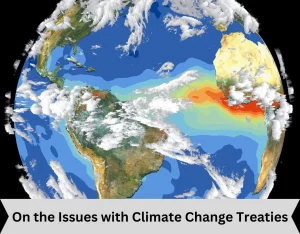ForumIAS announcing GS Foundation Program for UPSC CSE 2025-26 from 27th May. Click Here for more information.
Source: This post on the Issues with Climate Change Treaties has been created based on the article “How to enforce climate agreements with trade measures” published in “Business Standard” on 27th January 2024.
UPSC Syllabus Topic: GS Paper 3 Environment – Environmental pollution and degradation.
On the Issues with Climate Change Treaties, The article discusses the issues with climate change treaties and the steps that can be undertaken to tackle them.
A detailed article on UNFCCC COP28 can be read here.
According to the author, the Dubai Agreement, as part of the UN Climate Change Conference in Dubai (COP28), will not have much impact on combating climate change.
What are The Issues with Climate Change Treaties?
1) Voluntary Commitments Not Working: Voluntary commitments entail no accountability. For instance, at the formation of the UNFCCC in 1992, all countries committed to preventing climate change, but emissions have continued to rise.
2) Issues with Economic Models: Economic models that intend to identify optimal climate policies often underestimate the benefits of emissions reductions and overestimate their costs.
3) Not Considered Important: In a world of urgent challenges, policymakers and the public have limited attention for climate change.
4) Non-Cooperative Unilateral Approaches: For instance, EU’s Carbon Border Adjustment Mechanism (CBAM). This prevents cooperation.
What Should be Done to Tackle The Issues with Climate Change Treaties?
As shown by the Montreal Protocol (which bars participating countries from trading in ozone-depleting chemicals (CFCs)) with non-participating countries) and MARPOL (access to ports is restricted to ships that meet certain technical standards), the following steps can make climate change treaties more effective:
1) Targeted Approach: Agreements should aim at achieving progress in narrow, but crucial, economic sectors.
For instance, the Montreal Protocol, which protects the stratospheric ozone layer.
2) Legal Obligations: Unlike the voluntary commitments made at each climate-change COP, these two treaties established binding obligations that can be enforced through international trade markets.
3) Positive Feedback Loop: The more countries that agree to participate, the higher the pressure on others to join.
4) “Common but Differentiated” Responsibilities: To succeed, international climate agreements must be compatible with countries’ economic strategies. They should include provisions whereby richer countries agree to help poorer countries in terms of finance or technology.
These steps should be replicated for other major emissions sources. For instance, Aluminum production.
Through these changes, the world will have a better chance to achieve rapid and equitable transition to net-zero emissions.
Question for practice:
What are the issues with climate change treaties? What should be done to tackle them?





